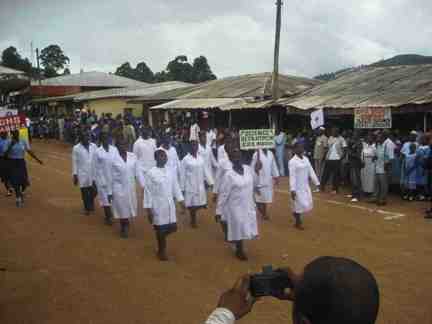
Science Club from a Local High School
In the United States, we see countless images meant to represent poverty in Africa that focus on civil unrest, starving children, HIV/AIDS, and other diseases. The images come from our media, our government, even charities and NGOs working to fight the affects of poverty. But we see very little of two key areas: 1) the progress made by individuals, families, and communities who are facing poverty every moment of their lives and in every single decision they make and 2) the impact of our American lifestyle that creates and exacerbates the violent conditions of poverty around the world. I’m not talking about idioms like “Clean your plate! There are starving children in Africa!” Although our consumption patterns and our obsession with low prices at any cost are severely unhealthy to ourselves as well as the rest of the world, today, I’m referring to other elements of our lifestyle in relation to poverty, at home and abroad.
My point is draw attention to the bizarre romanticism, exoticism, and emotional distance that we create between our “safe, protected” lives and the realities of the majority of the world’s population.
Do these disciplined happy high school students match our common image of poverty in places like Cameroon? Not really. But do their mothers, fathers, grandparents, or other guardian live on more than $2/day, the international marker for poverty? Probably not. Many live on their own, with extended family, or family friends, and earn money outside of school to pay for books and other fees. Furthermore, do these teens have easy access to potable water? Hardly. They most likely carry it in buckets from a public tap that may be shared among the entire village. Do these students have mosquito nets for nightly protection from the risk of malaria? Probably not.
These teenagers are representing their school’s Science Club in the annual March Pass (aka Parade) to celebrate Cameroon’s National Day of Unity, when English and French Cameroon united to form one country. One is even smiling and another is wearing earrings! One might ask, how can they be poor and happy or poor wearing jewelry and lab coats?! Or, they look well enough, why should I adjust my comfortable life to help improve theirs? These faces that are rightfully proud of their education and accomplishments do not fit with the images of poverty that we glamorize in the U.S.. But I assure you, most of these children and teens conquer the daily struggles of living on $2 or less per day. Or, even if their guardians earn more than $2/day, their lives are far from easy or simple.
To look at the flipside, I question whether the “work of living” inherently equals suffering. If we set aside the issues of nutrition and illness and their dangerous prevalence in the general population in a place like Cameroon, is the overall quality of life inherently lower than the extravagant American lifestyle? The other day, a difficult question was posed to me: “Are we [Cameroonians] suffering here?” My reaction was to feel very uncomfortable, so I simply answered, “You look happy to me.” And yet, I think about it in terms of quality of life and how we define suffering. The working and middle class Cameroonians I have met so far work very hard in the “labor of living” – washing clothes by hand, cooking for hours over an open 3-stone fire, pounding corn to make fufu, and the list continues. These Cameroonian’s probably make $6-10/day, which is significantly more than the poverty level where people are most likely suffering from increased risk of disease due to poor nutrition and lack of access to medicine and potable water. But still, based on a superficial glance, most of my peers in the United States would consider these middle class Cameroonians as still poor, just based on the lack of convenient appliances and technologies at their fingertips.
Faith Garlington is a Kiva Fellow volunteering with GHAPE (Grounded and Holistic Approach to People’s Empowerment) in Bamenda, Cameroon. To learn more about GHAPE, visit the Partner page at Kiva or the GHAPE website. Get involved by lending or joining Team GHAPE!
http://fellowsblog.kiva.org/2011/07/05/faces-of-poverty/











If anybody is interested in learning how international ''health'' agencies manage to relabel malaria and TB ''AIDS'' watch the latest documentary expose called House of Numbers on Youtube.
ReplyDelete